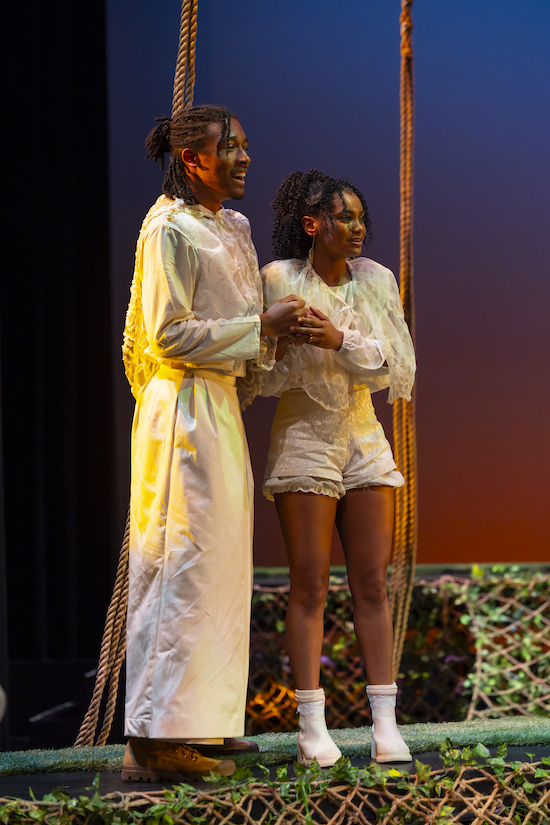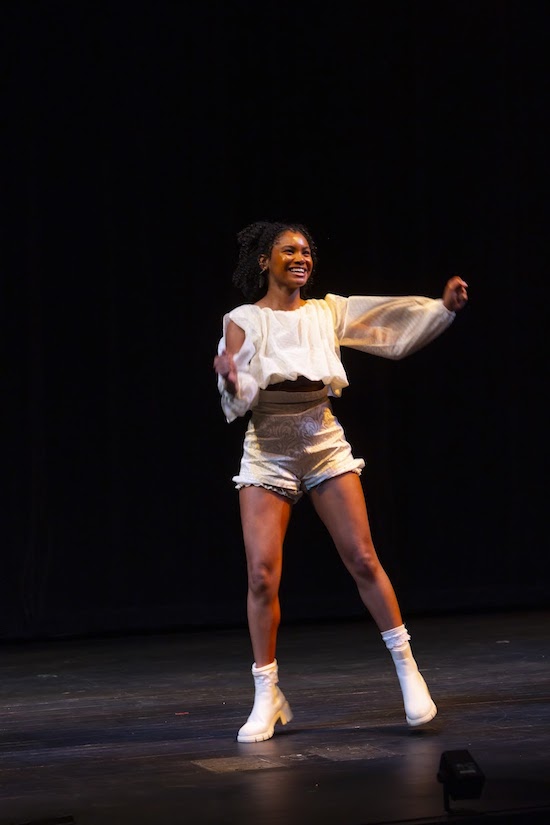
The final theater department thesis performances of the school year took place on Feb. 27, 28, and March 1. At 6:30 p.m. each evening, CJ Joseph ’25 presented “Dance Monkey, Dance,” an immersive performative lecture that examined the relationship among Black female performativity, political visibility, and fetishic fear. After collecting a program in the Zelnick Pavilion, I was greeted by the enthusiastic faces of the only other actors in the show (Sophie Taubman ’25 and Cory Garcia ’25), asking if I was here for the lecture. I nodded and headed through the glass double doors to find my seat in the Patricelli ’92 Theater. The performance had begun.
Once they’ve ushered the audience into the theater, the two student greeters, Samantha (Taubman) and Kevin (Garcia), march in. They radiate excitement about the imminent lecture by fictional scholar and actor Bea-Amina Smith (Joseph), whom they’ve invited to present to their peers on her research on fetish-like fear and Black female performativity. The two discuss their admiration of Smith’s prolific acting career and speculate on which of her iconic performances she’ll focus on in her talk. When Smith finally arrives, they show her to the podium and flitter around, eagerly preparing for her lecture to begin. Even in these early moments of the production, Taubman and Garcia portray their characters with precision, making clear their manic devotion to Bea-Amina Smith, which was simultaneously comical and off-putting.
Once the students are settled, Smith begins her lecture by defining the foundational concepts of her research. In an email to The Argus, Joseph delved further into the theoretical concepts that Bea-Amina Smith presented during the lecture.
“[Following] my initiation into the concept of opacity and performance…I became captivated by the tension between an artist’s intent and the reception,” Joseph wrote. “My interest in fetishistic fear and political visibility emerged [while taking] ‘Immigration and the Politics of Fear’ (ANTH301). Early in the course, we explored the theory behind fear as a politicized emotion…. I wondered: When does an object of disgust transform into an object of fascination?”
Throughout Smith’s lecture, Samantha and Kevin constantly interrupt her to ask questions about their favorites of her acting roles. At first, she patiently responds to each query before returning to the topic at hand. However, as the lecture continues, their interruptions become more frequent and intrusive. Notably, many of their questions center around how her experience as a Black woman affected her acting choices in each role.
Eventually, Smith asks to take a break, fed up with their lack of attention to the topic she intended to present on. This scene poignantly demonstrated the points of Smith’s earlier lecture: when Black women perform or present in public, other people fixate on certain aspects of the performance while dismissing others. Joseph shared how she modeled both characters on interactions she’s had on and off campus while discussing her work as an actor.
“As a Black woman and an artist, the question [of the tension between an artist’s intent and a work’s reception] became particularly pressing, especially after my experience in an acting program over the summer,” Joseph wrote. “There, I encountered the same phenomena I had observed at Wesleyan—people selectively latching onto certain aspects of my performance while misinterpreting or outright disregarding my full presence. Rather than acknowledging me holistically, they extracted and emblemized fragments of my identity. This pattern led me to a broader fascination with meta-semantics, linguistics, and opacity, particularly as they relate to the ways Black communities—and Black women specifically—are consistently misconstrued or deliberately manipulated to fit others’ mental schemas.”

While Bea-Amina Smith is offstage, Samantha and Kevin continue to enthuse over her acting work and hang pictures of her acting in various roles all over a white board, citing her role as Antigone in “Antigonick” (a real role in a real play that Joseph portrayed in a campus production) as one of their favorites. When Smith returns, the students ask her to perform a monologue from the show, insisting on it despite her initial refusal to do so. Smith delivers a powerful rendition of the monologue, with Kevin and Samantha filling in the lines said by the chorus as though they’ve been rehearsing for months.
After the monologue, they ask for her to perform a scene with Kevin from “Fucking A” and it quickly becomes uncomfortable as the scene involves a kiss between Kevin’s character and Smith’s. Finally, Smith pushes back against the students’ crossing of her boundaries and challenges their assumptions about how her experience as a Black woman has influenced her work as an actor, pointing out that the main character in “Fucking A” isn’t even described as a Black woman. Joseph chose to include scenes from those shows due to their relevance to the themes of her thesis, but she explained that all of her experiences in acting have also informed her research and production in some way.
“Every role I have embodied found its way into my thesis in some form—whether through costuming, the name I selected, or specific acting choices,” Joseph wrote. “Their presence onstage, symbolized by photographs, was my way of honoring them. My return to Hester was particularly significant; when I first read ‘In the Blood’ and ‘Fucking A,’ I instinctively envisioned her as a Black woman. This initial assumption intrigued me, compelling me to interrogate why I had found solace in a character who, in the text, is not explicitly racialized as such.”
At the end of the performance, Joseph broke character to start a dialogue with the audience, asking for volunteers to share what they learned from her lecture. After a couple of responses, she invited us all down to the stage, where we could keep participating in the discussion and take a closer look at the pictures of her in various performances. The show ended with Joseph’s heartfelt expression of gratitude to those who helped her complete her thesis and relief that it was coming to an end, producing an atmosphere of somber reflection and emotional catharsis in the final moments of the play. Ultimately, Joseph delivered a stirring performance that struck a delicate balance between teaching complex academic concepts in a digestible way and relating her personal experience to performance.
“I am done explaining Black struggles, particularly those of Black women,” Joseph wrote. “Some people will never listen, and I have had to accept that—especially given some of the responses from white audiences. There will always be those who approach me with expectations I refuse to fulfill. At the end of the day, I choose joy, and I will seek it in ways that serve me, not in ways that accommodate my audience.”
Joseph also stressed that these thoughts are not hers alone.
“Black women have expressed these same frustrations, which is what inspired this work in the first place,” Joseph wrote. “I want Black women to find solidarity in one another. I want white audiences to walk away, at the very least, unsettled—perhaps confused, or simply saying, ‘Damn, that was a thesis. Something that was theoretical, academic, complex, yet deeply rooted in theater.’ Above all, I want people to leave with a sense of grounding, a sense of immersion, or a sense of confusion—one that sparks further exploration and consideration.”
Sulan Bailey can be reached at sabailey@wesleyan.edu.


Leave a Reply